
 |
|||||
|
|
|||||
|
|
|
|||||
|
|
MORLEY CHURCHYARD APPLE Stephen Jackson of Smalley, in Derbyshire, introduced us to this ancient tree, growing in the churchyard at Morley, close to Smalley, and sent wood to graft around 2012. The church is believed to be of Saxon origin and the village is very old. There are still traces of a Roman road passing through the neighbourhood – from Tynemouth to St. Davids and called Ryknield Way. The tree itself is very much decayed and the trunk no longer alive for some of its circumference. There appears to be no record of its origin or why it still grows there. There is also a very ancient chestnut tree in the churchyard. Apples are medium sized, oval and richly flavoured but we have yet to learn its full nature. Pollination Group ? |
|||
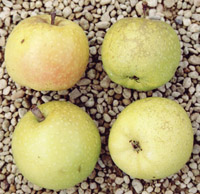 |
MOSES TREE Sent to us by the organizers of the Dorchester apple day at Kingston Maurward College, several years ago. It was brought to the apple day by the owners of a very old tree, the variety name of which was uncertain. It was known simply as the Moses Tree, by the family. The fruit turned out to be of top quality. A dessert apple of medium size, slightly oblong and flattened at the ends, with skin of pale yellow green, sometimes with a warm blush and liberally speckled with large pale dots. It has occasional areas of thin netted russet. Spur bearing, it is ripe from mid-September and will last to the end of October or beyond, depending on the warmth of the summer. The flesh is firm to crisp, fine, juicy, sweet and aromatic, with a rich, complex flavour, sometimes like pineapple. It is unusually early to come into leaf. Pollination Group 3 |
|||
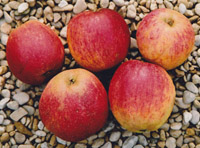 |
MOTHER
Also called American Mother. A middle to late season dessert apple thought
to have been introduced by Thomas Rivers, of Sawbridgeworth, Hertfordshire,
in the 19th century, and originally from Massachusetts. Brightly coloured,
longish apples, yellow with a dark red flush and streaks. They are richly
sweet, aromatic and juicy, with a hint of cinnamon, firm rather than crisp,
and will store until December. Attractive trees, with deep pink blossom.
A very good apple. Pollination Group 5 |
|||
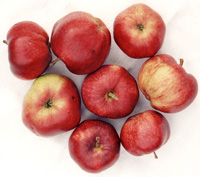 |
MYRTLE’S
MYSTERY
When Hilary Wilson, of Appleby-in-Westmorland, returned to an old orchard
known to her in childhood, in Osbaldwick, near York, where many years
before she went scrumping with her brother, she found two interesting
old trees. The owners, Mr and Mrs Goodwin, each pointed to a different
tree, identifying them as Red Balsam. It turned out that Mr Goodwin was
correct and the other apple tree was an unknown, but very good and very
colourful dessert apple. The late Myrtle Goodwin is commemorated in this
apple, now named after her by Hilary Wilson. It is small to medium sized,
flattish oblong, ribbed, especially around the eye and with a wide basin.
The pale yellow skin is flecked and streaked with carmine and crimson.
The flesh is sweet, juicy and crisp with a very good fruity flavour. Ripe
in October and keeping well into November or beyond. Pollination Group
4 |
|||
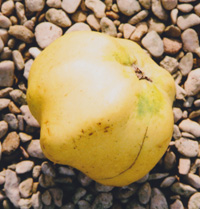 |
NANCY
CROW Hilary Wilson, one of the first pioneer fruit hunters, of
the modern age, has discovered many old trees in the North-West and encountered
this one in the possession of Nancy Crow, in the Lune Valley, Westmorland,
between Kendal and Lancaster. Nancy, who died recently in her 80s, said
that she had always believed it was Keswick Codlin because her father,
who also died in his 80s, had believed that. Though it bears some similarities
Hilary knew it was not Keswick Codlin and a DNA test has shown it to be
unmatched with any other tested apple. It is now named Nancy Crow. This
tree grew as an unpruned bush in an area notoriously damp and wet, even
by Westmorland standards, yet Hilary deems it the hardiest and healthiest
of all the many trees she has known in the North-West, with apples unblemished
by the disfiguration and rot that affects so many apples, locally, in
humid years. The burrs showing on the wood reveal that it is one of the
few apple varieties that will root from cuttings – a ‘burr
knot’ tree. The apples are yellow when ripe with a few red streaks
and, though ribbed like Keswick Codlin, the ribs are often more pronounced
and Nancy Crow is flatter and wider. Apples are ripe in early October.
The flesh is light but fine and tender, juicy enough and sweet enough
to eat raw with a reasonable flavour. It cooks quickly and keeps its shape,
if cooked carefully, but the flesh would mash. It then reveals a very
rich flavour, lemony but quite sweet enough without sugar added. A very
good apple, with scions first sent to us by Hilary many years ago now,
but long overdue for inclusion here, under a gentle nudge from Hilary.
Pollination Group 3 |
|||
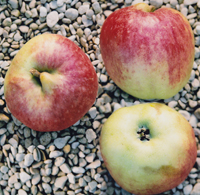 |
NANCY
LEE A mature tree, probably arising as a ‘Wilding’,
from a discarded core or an apple dropped from a nearby farm orchard tree,
now long gone. It was ‘adopted’ by Dr Alexandra Freeman of
Steventon, Oxfordshire, who lived close to it many years ago, outside
Blewbury, now in Oxfordshire, but in Berkshire before the 1974 boundary
changes. Alexandra has named it Nancy Lee, after her grandmother. She
kindly brought us cuttings in 2012 and sent apples later. The tree is
very tall and buried within a thicket of hedgerow, on the edge of the
ancient Woodway Road that leads out of Blewbury and up into the Berkshire
Downs. It is a large conical apple, with a pronounced fleshy lip at the
stalk, green with a bit of a blush and a few bright red stripes, and is
middle to late season, probably at its best at the end of October, though
it will keep longer. It is a good eating apple and also cooks well. Eaten
fresh, it is sweet, crisp, fine-fleshed and juicy, with a good flavour.
Cooked, it keeps its shape completely but becomes very tender, very rich
and sweet with a pleasing mild tang, hinting of quince. It does not discolour,
when cut, overnight. We are grateful to Alex for bringing such a good
apple to us. Pollination Group 3 |
|||
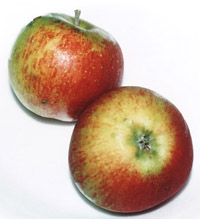 |
NANNY
First noted in the 1842 catalogue of the London Horticultural Society.
Taylor (1946) suggests it was raised in Surrey, from a report by Mr J.
Cheal of Cheal’s Nursery, though all the earlier references suggest
it was a Sussex apple. Hogg said it was from West Sussex and the Hampshire
borders, Bunyard said it was not often encountered outside Sussex and
Barron records in 1883 that it was exhibited from Midhurst, Sussex. A
dessert apple which needs to be eaten at the right moment, before it becomes
mealy. Hogg says it is in season in October, but the consensus is that
it is best a month earlier. A medium sized fruit, roundish, slightly angular,
with skin of green-yellow and broken red streaks in the shade, more fully
red with dark crimson streaks in the sun, speckled with russet dots. The
flesh is yellow, soft, juicy, and sweet, with a rich flavour. First rate,
according to Scott, if gathered before ripe. Barron said it had long been
a favourite apple in Sussex. It has also been used as a cider sweet. Pollination
Goup 4 |
|||
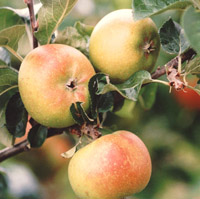 |
NEW
ROCK PIPPIN An early nineteenth century dessert apple, raised
at Barnwell, near Cambridge and exhibited at the London Horticultural
Society in 1821. Medium sized fruit with crisp, juicy, richly flavoured,
aromatic flesh. The skin is dull green with brown/red colouring. It is
quite late to ripen, in early November, and it stores well, up to the
end of the year, perhaps longer. A good apple that deserves wider planting.
Pollination Group 4 |
|||
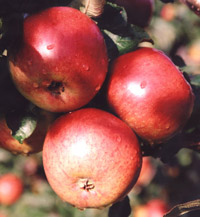 |
NEWTON
WONDER There are two stories of the origin. One says it was found
by an innkeeper, growing in the thatch of the Hardinge Arms, King's Newton,
Derbyshire. Another says it was raised by Mr Taylor of King's Newton,
as a cross between Dumelow's Seedling (Wellington) and Blenheim Orange.
It was introduced by Pearson & Co, of Nottingham, around 1887. A late
season dual purpose apple which cooks to a creamy purée and makes
good baked apples and mincemeat. The large fruits are good for dessert
when fully ripe in late October. It has been popular in the North as it
is very hardy and resistant to disease. It has heavy crops -1,840 pounds
of fruit were once recorded from one tree. The apples will store until
March. Attractive, spreading trees. Pollination Group 4 |
|||
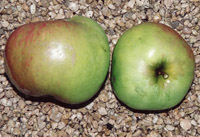 |
NEWTOWN PIPPIN Also called Albemarle Pippin, it has been assumed to be an American apple, introduced to Britain in 1759, from Long Island, New York. However, there is some evidence to suggest it was taken from England to America in 1666. There is much to be said of this important apple, but it would fill pages. Having come back from America it became much praised all over Europe, as it was in America, throughout the 19th century, for its rich pineapple flavour. It was once widely grown in the southern counties, ripening better in warmer climates, though higher temperatures now release it to the North. Crisp and very juicy, rich fruit is ripe in October or November. Though part tip-bearing, it is not short of spurs. Apples will store until March. Pollination Group 3 | |||
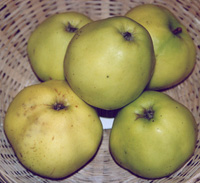 |
NINE
SQUARE This large culinary, eating and cider apple was grown
chiefly in Devon, Herefordshire, and the West of England, and was first
described in 1824. The National Apple Register records that it was still
in existence in 1947, but it was thought to be extinct in modern times
until its rediscovery in Somerset by R.J.Maynard. The flesh is firm and
sweet, when the fruit is ripe in October and will store to the end of
the year. When cooked, it keeps its shape, with a fair, sweet flavour.
Pollination Group 5 |
|||
|
||||